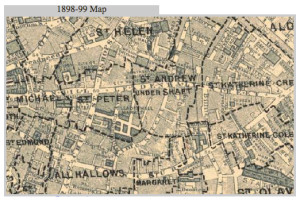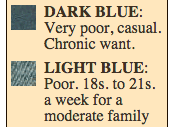I chose to focus on Leadenhall Street from the Sherlock Holmes story, A Case of Identity for this mapping/research assignment. This image is screen-shotted from the Victorian Google Maps website. Leadenhall Street is the thick, long street running horizontal through the image.
On the Old Bailey Archive I did a search of Leadenhall Street in the 1800s and found man phrases that much of what came up seemed business related, as if Leadenhall was a bustling, though not incredibly wealthy, business district with many places of employment and local businesses. Here are some examples of what I found that lead me to make this conclusion:
-“…I am a clerk at the post office, 114, Leadenhall Street…”
-“…Holder Brothers, Ship brokers, 146, Leadenhall Street…”
-“…he was an advertising agent in Leadenhall Street…”
-“…I am a printer, of 18, Leadenhall Market…”
-“…I am a tea importer, of 158, Leadenhall Street…” etc.
On the Charles Booth Online Archive I searched for the Street and came up with the following 1898-99 map.
According to the legend, the coloring of the map showing the surrounding areas of Leadenhall Street indicate that this was not a wealthy area. It seems that most of this area (the light blue range) is poor and some (the dark blue) indicates very poor areas. I can’t really tell if there are actually dark blue areas or if it’s just light blues layered on top of each other making certain spots look darker. Anyway, from this information and what I previously discovered about the many businesses along Leadenhall Street, it seems that it was a very working class area where people just barely managed to scrape buy and support their families and provide the necessities. Maybe there aren’t quite and “very poor” dark blue areas because there are lots of small local jobs in the area so people are not in the range of “chronic want.”
On the Locating London website, I did a search of Leadenhall Street to discover what typed of crime were reported in this area in the early 1800s. What I found were that all of the offenses were related to theft: pickpocketing, grand larceny, coining offenses, theft from a specified place, shoplifting, highway robbery, etc. I supposed this makes sense if the area was full of businesses and people just barely making it by. I’m not associating the poor with the crime, but these people were, in some way, wanting (indicated by the map showing wealth), and this could lead to theft.


